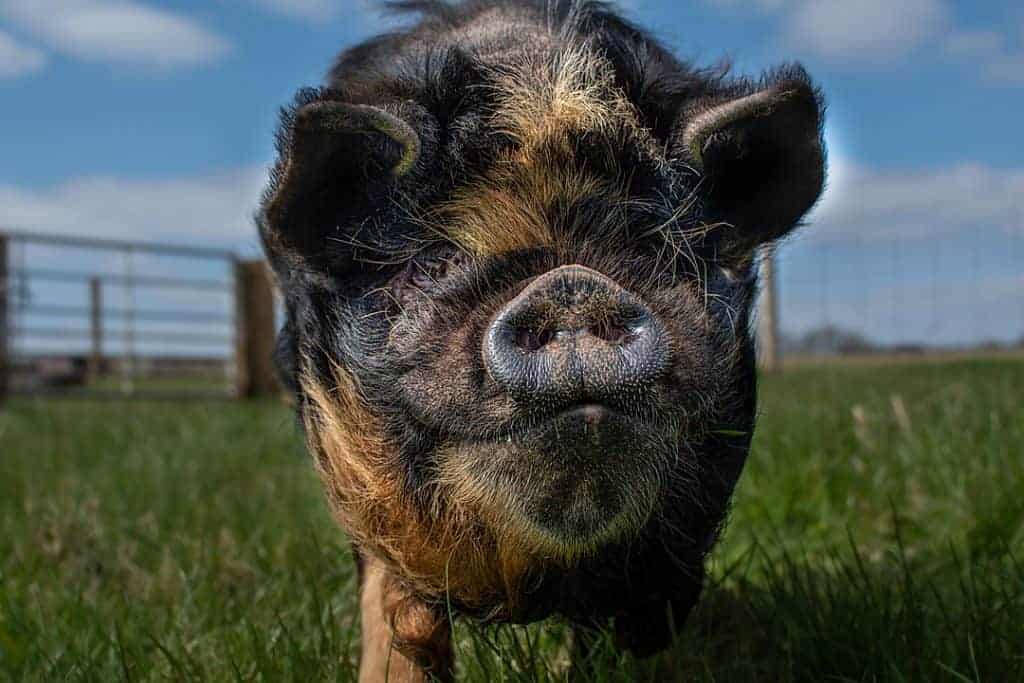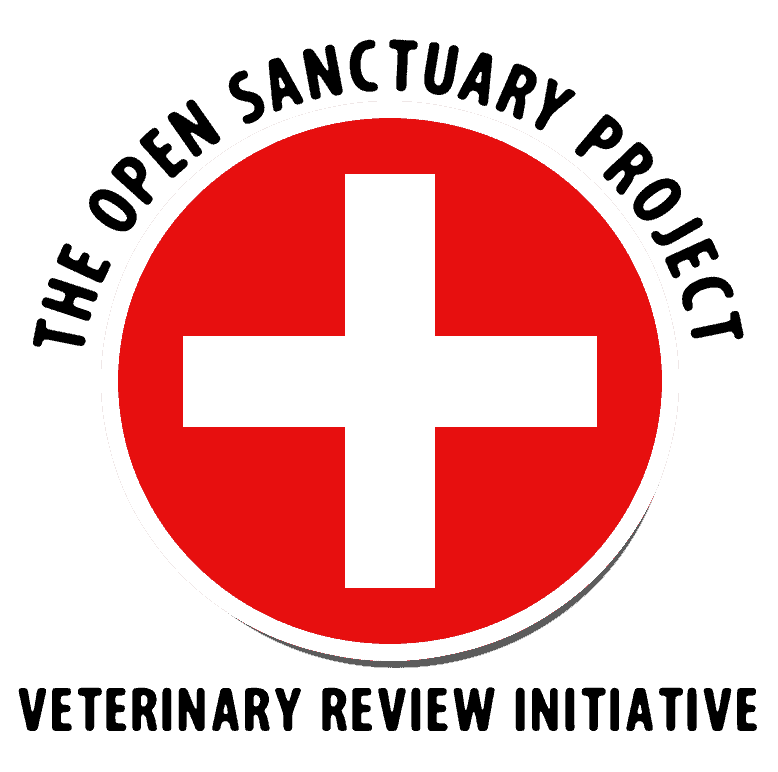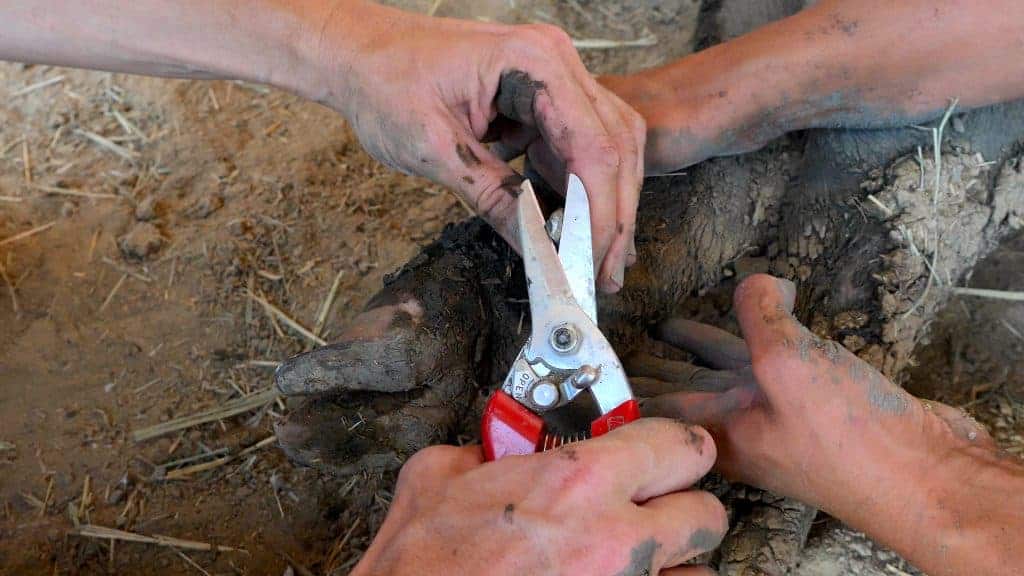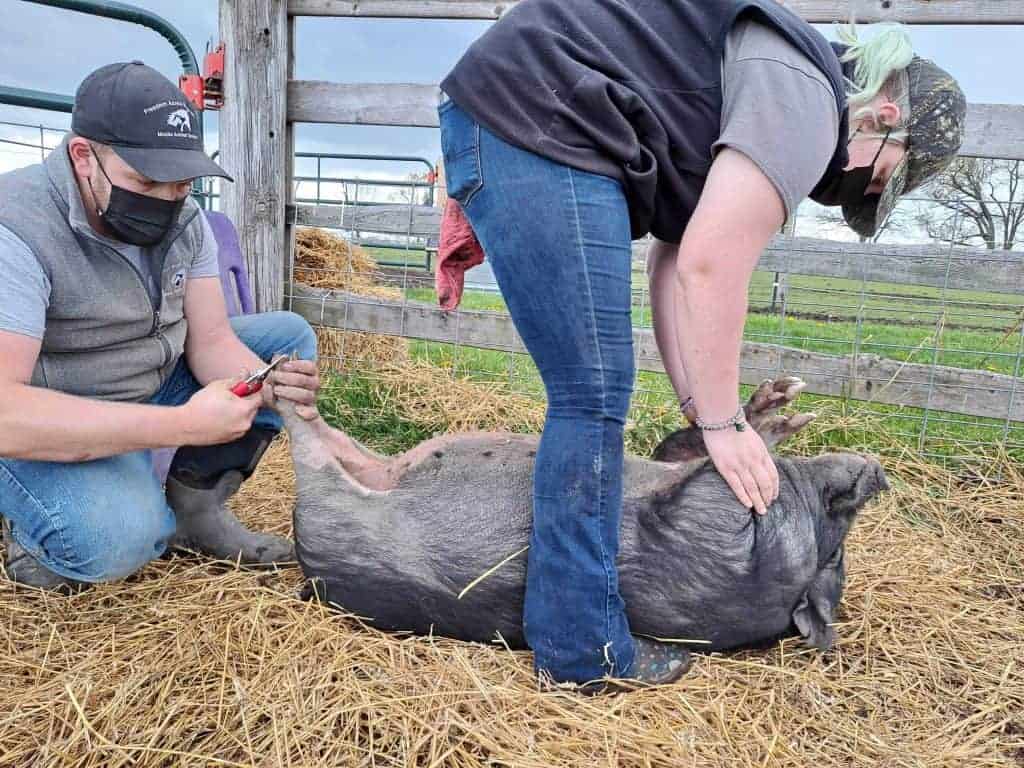

Veterinary Review Initiative
This resource has been reviewed for accuracy and clarity by a qualified Doctor of Veterinary Medicine with farmed animal sanctuaryAn animal sanctuary that primarily cares for rescued animals that were farmed by humans. experience as of March 2023. Check out more information on our Veterinary Review Initiative here!
Hoof care is important for all hoofed residents, but providing proper hoof care for pigs can be a bit more challenging than for other species. Finding a farrierSomeone who provides hoof trimming and care, especially for horses or cows who works with pigs can be nearly impossible in some areas, and whether you trim their hooves yourself or work with someone else, pigs (and especially large breedDomesticated animal breeds that have been selectively bred by humans to grow as large as possible, as quickly as possible, to the detriment of their health. pigs) pose unique challenges when it comes to safely trimming their hooves. However, even with these potential challenges, regularly evaluating your pig residents’ hooves, and trimming or filing them as needed is imperative for their comfort and health.
Why Is Hoof Care So Important?
Without proper hoof care, pigs can develop various conditions that can affect their quality of life and possibly predispose them to other more serious issues. While some individuals may wear down their hooves naturally and not require regular hoof trimming, others will need their hooves trimmed to prevent them from becoming overgrown. Overgrown hooves can cause hyperextension of the joints of the leg which can result in lameness and damage to joints. Hoof cracks can occur even in properly trimmed hooves, but are especially common when hooves are overgrown. Cracks in hooves allow pathogens to enter and can lead to infection. Close observation and regular evaluation of hooves is imperative to ensure issues are addressed before they become more serious.
Hoof Trimming Basics
The frequency at which an individual will need their hooves trimmed varies, but by regularly evaluating their hooves, you’ll be able to schedule hoof trimming and any other hoof care as needed. We recommend hooves be checked during routine health checks and that caregivers be trained to look for signs of hoof issues and lameness during daily observation.
Nothing Beats Hands-On Training
The following information is purely informative and is not a replacement for hands-on training. Hoof care is incredibly important, and improper trimming can negatively impact a pig’s comfort and mobility. If you do not know how to trim hooves or are working with a resident whose hooves require more intensive trimming than you have experience performing, we recommend you reach out to a veterinarian, farrier, or pig care expert for guidance. Always ask a veterinarian for guidance about a potential medical issue.
Objectives
When assessing a pig resident’s hoof, the goal is to do the following (but not necessarily in this order):
- Check the coronary band for heat, swelling, sensitivity, or discharge which could indicate infection. If the individual’s feet are dirty, you will want to clean them so you can properly assess them.
- Evaluate the length of each claw and return the claws to a reasonable length, if needed, without cutting into the sensitive corium (sometimes referred to as the “quick”). It may be easier to visualize the corium in light hooves rather than dark, and the use of a light can aid in this process. Overgrown toe tips should be trimmed, taking off just a little bit at a time to prevent cutting too short. Often, the outer claw will be more overgrown than the inner claw. In most cases, you should be able to trim the outer claw to match, or almost match, the length of the inner claw.
- Observe the shape of the claw and restore it to a normal shape, if necessary. In a properly shaped claw, the hoof wall should be straight and the toe tip rounded horizontally. Overgrown claws may curve inwards and/or the top of the hoof may become concave. After addressing the length, you can carefully trim or file the hoof wall to correct this – again, be careful not to remove too much, or you will hit the sensitive corium.
- Assess the bottom of the claw, trimming or filing as needed, to restore a balanced weight-bearing surface. The hoof wall should be even with the sole, but sometimes it starts to form a lip that needs to be trimmed. If the heel is overgrown, this can also be very carefully trimmed. Be aware that it is normal for the heel to be slightly convex rather than being even with the sole. However, if it is significantly overgrown, it will require trimming, especially if it has formed a hard callus or flap of skin. Trimming of the heel must be done carefully and may require a professional. There should not be any separation between the heel and the sole or any cracks in the heel. Heel cracks and erosion are not uncommon, but depending on the severity they can be painful and put the individual at risk of infection. Consult with your veterinarian if you suspect issues with the heel.
- Trim and shape dewclaws, as needed, without cutting into the sensitive corium. Overgrown dewclaws are quite common – in severe cases, they may become so overgrown that they begin to curve. Overgrown dewclaws are also at risk of getting caught on things, broken, and even torn off completely. To evaluate the length of the dewclaws, watch the individual while they are standing – the tip of the dewclaws should be about even with the coronary band. To evaluate dewclaw length in an individual who is not standing, flex their foot to mimic a standing position. Overgrown dewclaws can be filed to restore their natural shape after bringing them back to a normal length.
- Check for issues such as hoof cracks, and contact your veterinarian if there are any signs of infection or if you are unsure of how to properly address the issue. Shallow cracks can be carefully buffed out with a sanding tool. Contact your veterinarian for guidance if one of your residents has a deep crack or if they are showing signs of infection.
More On Hoof Cracks
Pigs can develop vertical or horizontal cracks (fissures) in their hooves. Cracks can range from shallow/mild to deep/severe. Vertical cracks may originate at the coronary band or where the hoof meets the ground while walking and may be short or run the entire length of the claw. While shallow cracks can often be buffed out with a sanding tool, deep cracks can result in lameness, inflammation, and infection. Vertical cracks associated with the coronary band are especially concerning because they can result in infection deep in the foot. Be sure to contact your veterinarian if one of your residents has a deep vertical crack, a crack originating at the coronary band, or a hoof crack plus lameness, sensitivity, discharge, heat, or other concerning finding. They can evaluate the individual and make treatment recommendations. If infection is a concern, radiographs may be recommended to assess bone involvement.
Digital Multi-Stage Walkthrough
For those looking for a more interactive way of learning about the trimming process, the following section contains five stages of a typical pig hoof trimming experience, starting from an overgrown hoof, and how it should appear after each major milestone of trimming. You can rotate and zoom the model in each stage to get a better sense of what you may be looking at from various angles!
Trimming Tools
There are a variety of tools you can use for hoof trimming and shaping. These include:
- Trimming shears (often marketed as “goat hoof trimmers”) – Smaller than nippers, this scissor-style trimmer can work well on dewclaws and softer claws, but may not be strong enough for hard overgrown hooves or thick dewclaws.
- Hoof nippers (often marketed for equines) – Larger than trimming shears, nippers work well for hard overgrowth and can be used for thick dewclaws.
- Rotary tools (such as a Dremel or Hoof Boss) – Some folks swear by rotary tools, especially the Hoof Boss, and prefer these tools to shears and nippers. Others use nippers or shears to trim excess length and then use a rotary tool to shape and smooth the claw and to address shallow hoof cracks. One potential downside to rotary tools is that residents may not like the sound or vibrations, and therefore may not tolerate these tools without being restrained or sedated.
- Hoof rasp and file – If you prefer not to use a rotary tool, it’s a good idea to have tools on hand to help shape and balance the hoof.
- Styptic powder or other blood-stop product – just in case!
Methods
It’s important to make hoof evaluation and trimming as stress-free as possible for your residents, but what that looks like really depends on the individuals in your care and your sanctuary’s Philosophy of Care. In this section, we’ll discuss some of the different methods used for hoof trimming as well as their pros and cons. The lists of pros and cons are provided to give caregivers a starting point when considering the most appropriate method(s) for the residents in their care. It is up to each sanctuary and caregiverSomeone who provides daily care, specifically for animal residents at an animal sanctuary, shelter, or rescue. to decide how the potential benefits and risks of each method compare and to consider additional risks or benefits that are specific to their residents. What works for one sanctuary may not work for another, and even within one sanctuary, what works well for one particular resident may not be the best option for another.
Method 1: Drug- And Restraint-Free Trimming

For this method, care staff evaluates and, if necessary, trims a resident’s hooves without restraining them or using medication to sedate them. Often, this method involves one person rubbing a resident’s belly while another performs the evaluation/trimming. Another popular method is “forking,” which is common with mini pigsThe term “mini pig” is used to categorize smaller breeds of pigs, such as Potbellies, Julianas, and Kunekunes, and to differentiate between these breeds and large breed pigs, such as Yorkshires, Landrace, or Hampshires, who are sometimes referred to as “farm pigs”. The descriptor “mini” can be a bit misleading- some breeds of mini pigs can weigh over 200 pounds! Terms like “teacup”, “micro”, “pocket”, “nano”, and “micro mini” are deceptive terms that are sometimes used to intentionally mislead people into thinking an individual pig will remain a certain size.. Basically, you use a fork, or similarly pointy but not dangerous instrument to gently poke and scratch the individual. Some pigs will flop over the second they are touched with the fork or the second they anticipate a belly rub. Of course, this method relies on the resident enjoying a belly rub/forking and tolerating having their feet touched. This method works best if you spend time familiarizing your residents with the feeling of having their feet touched (starting without even attempting to trim their hooves and slowly working up to actually attempting to trim). If you rescue young piglets, we recommend you get them used to having their feet touched early as this can make things much easier for everyone later on! You may find that with this method you can only work on one hoof, or even one claw, per “trimming session.” Instead of doing full trims multiple times a year, folks who rely on the belly rub/fork method often look at hoof evaluation and trimming as an ongoing process, doing a little bit here and there as their residents allow. Caregivers working with residents who are neither restrained nor sedated must pay close attention to the individual and their body language and vocalizations, being prepared to stop what they are doing and to quickly move out of the way if necessary (especially when working on front feet).
Pros:
- Least stressful option
- Caregivers can get a good view of the bottom of an individual’s hoof without putting stress on their legs
- Avoids the risks associated with sedation and restraint
Cons:
- Caregivers must be very careful and be prepared to move out of the way as needed to avoid accidental injury
- Can take a bit more time, so may not be a good option for someone who needs extensive work done to their hooves
- Likely not a great option for someone with a painful condition, as they will be less likely to tolerate their foot being touched
- Individuals who are comfortable having their hooves trimmed with this method may not cooperate once a rotary tool is turned on
Method 2: Restraint

Some sanctuaries prefer to restrain pig residents in order to evaluate or trim their hooves. Others only use restraint when absolutely necessary, such as if the individual will not cooperate for trimming with a belly rub. The method of restraint used will depend on the size of the resident and your staff’s training and capabilities. If you are working with a veterinarian or a professional farrier, you may also need to consider their preferences as well. Restraint options for mini pigs typically include sitting the individual on their bum, placing them on their back, or using a sling. Restraint for large breed pigs can be more challenging. Some sanctuaries have invested in a chute designed specifically for large breed pigs that lifts the individual off the ground. Other sanctuaries have attempted to make their own (non-lifting) chute, but we have yet to hear success stories (if you have successfully built your own chute for large breed pigs, please let us know!). While you may come across folks who recommend the use of a wire snare, this is an unacceptable method of restraint that can cause pain and injury. Some sanctuaries have opted to use a soft rope snare for restraint as needed, but other sanctuaries are strongly against this practice.
Pros:
- Can allow for all hooves to be done at once (vs. doing a little bit at a time without restraint), so might be a good option for individuals who need extensive work done or if multiple residents need their hooves trimmed at the same time
- Can make use of a rotary tool possible
Cons:
(please note that there are many different forms of restraint, and some of the points listed below only apply to one or some methods of restraint)
- Restraint can be stressful. Different individuals will have different responses to the various forms of restraint – some individuals may scream while snared or if they are sat on their bum or flipped on their back.
- Available restraint methods may not align with a sanctuary’s Philosophy of Care
- Even soft rope snares can cause abrasions to the sensitive snout
- Rope snares can become tight and difficult to remove
- Restraint methods that keep the individual in a standing position make it difficult to assess the bottom of the hoof
- Restraint methods that require a caregiver to lift or move the individual may result in injury to the resident or the caregiver
Method 3: Veterinarian-Prescribed Drugs

Another option is to talk to your veterinarian about the use of sedatives to make the process of hoof trimming easier and less stressful for the individual. Be sure to talk to your veterinarian about the risks associated with any medications. If you are sedating the individual solely for the purpose of a hoof trim, opting for the lightest sedation possible and/or only using medication that can be reversed is likely your safest bet. Full sedation is rarely necessary or advised for a routine hoof trim, but if one of your residents needs to be fully sedated for another reason, you may want to have their hooves trimmed while they are already sedated. Light sedation and restraint are sometimes used in combination to make restraint less stressful.
Pros:
- Can make hoof trimming easier and less stressful
- Especially useful for individuals who need extensive work done or who have a painful hoof condition
Cons:
- Sedation carries risks, with some medications carrying greater risk than others
- Requires veterinary involvement
Factors That Affect How Hooves Grow
There are numerous factors that affect how an individual’s hooves grow and how often they will need to be trimmed. Some of these factors are within your control and some are not. Hoof growth and hoof quality are affected by:
- Factors specific to the individual – Their body conformation, weight, gaitA specific way of moving and the rhythmic patterns of hooves and legs. Gaits are natural (walking, trotting, galloping) or acquired meaning humans have had a hand in changing their gaits for "sport"., and activity level will affect how they wear down their hooves. Obesity is one of the most common causes of overgrown hooves.
- Nutrition – Improper nutrition can interfere with healthy claw horn (hoof wall) production. If hoof issues are common at your sanctuary, talk to your veterinarian about the possibility that your residents’ diet may be a contributing factor. Important nutrients for horn growth include:
- Amino acids – cysteine, histidine, and methionine
- Minerals – calcium, zinc, copper, selenium, and manganese
- Vitamins – A, D, E, and biotin
- Environment – Your residents’ environment also affects how their hooves grow and wear down. While we recommend substrates that have some give and are easy on the joints, individuals who do not have any access to harder, slightly abrasive surfaces may not be able to wear their hooves down and may, therefore, need their hooves trimmed more frequently. Overly abrasive surfaces should be avoided as they can result in claw lesions. Additionally, prolonged wet conditions or unsanitary housing can make claws more susceptible to injury.
Concerning Findings
Hoof issues require prompt diagnosis and intervention to avoid debilitating and potentially life-threatening issues. If one of your residents has any swelling, heat, sensitivity, or discharge at the coronary band, is showing signs of lameness, or has a deep crack or other abnormality, be sure to contact your veterinarian right away. To see examples of different hoof issues you might encounter, you can check out Zinpro’s Lesions Scoring Guide. Please note that this is a non-compassionate source. You can find the scoring guide here. If you are ever in doubt about whether or not you should get a veterinarian involved, we recommend erring on the side of caution and giving them a call.
What Does ‘Unacceptable’ Mean?
At The Open Sanctuary Project, unacceptable means that we cannot condone (or condone through omission) a certain practice, standard, or policy. See a more detailed explanation here.
Article Acknowledgements
This resource could not have been created without the shared knowledge of compassionate pig advocates, including Kanda Farm Sanctuary, Tiny Hooves Sanctuary, and Happily Ever Esther Farm Sanctuary.
SOURCES:
Hoof Trims in Miniature Pigs | Lafeber Vet
Integumentary System: The Feet, Hoof, And Claw from Diseases Of Swine, 11th Edition (page 306) (Non-Compassionate Source)
Trimming Pig Hooves Can Prevent Lameness in Sows | Zinpro (Non-Compassionate Source)
Practical Understanding of Claw Lesions | Sarel Van Amstel, BVSc, College of Veterinary Medicine University of Tennessee, Knoxville, TN (Non-Compassionate Source)
Hoof Anatomy, Care and Management in LivestockAnother term for farmed animals; different regions of the world specify different species of farmed animals as “livestock”. | Purdue Extension (Non-Compassionate Source)
Non-Compassionate Source?
If a source includes the (Non-Compassionate Source) tag, it means that we do not endorse that particular source’s views about animals, even if some of their insights are valuable from a care perspective. See a more detailed explanation here.








